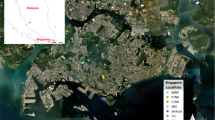Abstract
We used random amplified polymorphic DNA (RAPDs) to examine small-scale spatial genetic structure in the red alga Delisea pulchra (Greville) Montagne at two locations near Sydney, Australia. We examined genetic structure among plants at four spatial scales ranging from 2 km apart down to <50 cm apart between locations, among sites within locations, among quadrats within sites, and among plants within quadrats. Haploid stages of D. pulchra were absent from the populations studied, suggesting that they are maintained through asexual reproduction of diploid plants. Consistent with this, we found that 19 RAPD phenotypes scored in this study had multiple individuals, indicating the presence of clones in these populations. However, there were no RAPD phenotypes common to two locations separated by only 2 km. Analysis of molecular variance revealed that strong genetic differences occurred between plants from these two locations, with 46.3% of the total genetic variation occurring at this scale, most probably reflecting limited gene flow. Within each location, <25% of the genetic variation was attributable to differences among sites or quadrats, indicating gene flow at those smaller scales. Most of the variation within each location occurred at the smallest spatial scale, among plants within 0.25 m2 quadrats. Nonetheless, some pairwise genetic distances (φST) between sites or quadrats within locations were large, indicating some genetic divergence on smaller scales. Genetic distance was independent of spatial distance within both locations, suggesting that fine-scale differences within locations were most probably caused by variation in fine-scale patterns of water movement or fine-scale natural selection. We assessed the impact of one potential selective agent, grazing sea urchins, on the fine-scale genetic structure of D. pulchra. There was no evidence that grazing by sea urchins affected the genetic structure of D. pulchra. In combination with demographic data, our results indicated that local populations of D. pulchra within locations were relatively open and that fine-scale genetic structure was probably constrained by gene flow. At the larger scale however, strong genetic differentiation indicated little gene flow between locations and restricted dispersal of spores.
Similar content being viewed by others
Author information
Authors and Affiliations
Additional information
Received: 22 April 1999 / Accepted: 29 November 1999
Rights and permissions
About this article
Cite this article
Wright, J., Zuccarello, G. & Steinberg, P. Genetic structure of the subtidal red alga Delisea pulchra . Marine Biology 136, 439–448 (2000). https://doi.org/10.1007/s002270050703
Issue Date:
DOI: https://doi.org/10.1007/s002270050703




